Stena Line
Stena Line is one of the largest ferry operators in the world. It services Denmark, Germany, Ireland, Latvia, the Netherlands, Norway, Poland, Sweden and the United Kingdom, Stena Line is a major unit of Stena AB, itself a part of the Stena Sphere. Stena Line also owns the Swedish vessels of the otherwise German- and Danish-owned Scandlines.
 | |
| Private | |
| Industry | Transport |
| Founded | 1962 |
| Founder | Sten A. Olsson |
| Headquarters | Gothenburg, Sweden |
Key people | Carl-Johan Hagman (MD & CEO) |
| Products | Ferries, port services, passenger transportation, freight transportation, holidays, business travel |
| Revenue | |
Number of employees | 5,000 (2015) |
| Parent | Stena AB |
| Website | www.stenaline.com |

History
Stena Line was founded in 1962 by Sten A. Olsson in Gothenburg, Sweden, which still serves as the company's headquarters, when he acquired Skagenlinjen between Gothenburg and Fredrikshavn, Denmark.
In 1972, Stena Line was one of the first ferry operators in Europe to introduce a computer-based reservation system for the travel business area. In 1978, the freight business area also started operating a computer-based reservation system.
The first freight-focused route[1] started between Gothenburg, Sweden, and Kiel, Germany. The ship was the MS Stena Transporter.
During the 1980s, Stena acquired three other ferry companies. In 1981, Sessan Line, Stena's biggest competitor on Sweden–Denmark routes, was acquired and incorporated into Stena Line.[2] This included Sessan's two large newbuilds, Kronprinsessan Victoria and Prinsessan Birgitta, which became the largest ships operated by Stena by that date. In 1983, Stena acquired Varberg-Grenå Linjen, and two years later also the right to that company's former name, Lion Ferry. Lion Ferry continued as a separate marketing company until 1997, when it was incorporated into Stena Line.[3] In 1989, Stena acquired yet another ferry company, Stoomvaart Maatschappij Zeeland (SMZ) (which at the time traded under the name Crown Line). SMZ's Hoek van Holland–Harwich route then became a part of Stena Line.[4]
Stena Line doubled in size in 1990 with the acquisition of Sealink British Ferries from Sea Containers. This first became Sealink Stena Line, then Stena Sealink Line and finally Stena Line (UK), which now operates all of Stena's ferry services between Great Britain and Ireland.

In 1996, Stena Line introduced its 20,000 tonne HSS (High-speed Sea Service) vessels, which operated from Belfast to Stranraer, Holyhead to Dún Laoghaire and Hoek van Holland to Harwich. In addition to the three 1,500-passenger HSS vessels, Stena Line ordered two smaller 900-passenger HSS vessels to operate on the Gothenburg–Frederikshavn route. Due to the bankruptcy of the shipyard, only the first of these vessels was ever completed.
In 1998, Stena's operations from Dover and Newhaven were merged with P&O European Ferries to form P&O Stena Line, 40% of which was owned by Stena and 60% by P&O. In 2002, P&O acquired all of Stena's shares in the company, thus becoming the sole owner of P&O Stena Line, which soon changed its name to P&O Ferries.
In 2000, Stena Line purchased yet another Scandinavian ferry operator: Scandlines AB.
In November 2006, Stena ordered a pair of "super ferries" with a gross tonnage of 62,000 from Aker Yards, Germany for delivery in 2010, with an option for two more ships of the same design.[5] The new ferries will be amongst the largest in the world,[6] to be operated on Stena's North Sea route from Hoek van Holland to Harwich. The existing ships from the North Sea were to be moved to the Kiel–Gothenborg route, whereas the ships from Kiel would transfer to the Gdynia to Karlskrona route. The new ferries were launched in 2010, with Stena Hollandica entering service on 16 May 2010, and Stena Britannica planned to enter service in the autumn of 2010.[7]
The company also moved its Belfast Terminal from Albert Quay to the new VT4 during May 2008. This has reduced the length of the crossing to Stranraer by ten minutes.
In July 2009, Stena Line announced that it had repurchased its former ship, Stena Parisien, from SeaFrance. The ship is now known as Stena Navigator. She had a comprehensive refit. Following on from this, the ship was introduced on the Stranraer to Belfast route, alongside HSS Stena Voyager and Stena Caledonia.
A joint venture with Hyundai Glovis has been announced and approved by the European Commission in February 2019, for the implementation of a new cooperative short sea intra-European waters service in between the two carriers, for the sea transport of transhipment cargo originating from South Korea.[8]
On 14 March 2020, due to the Coronavirus outbreak, the company suspended operations between Oslo and Frederikshavn temporarily until further notice due to travel restrictions in Denmark and Norway, the routes sole ship the MS Stena Saga was sent to Gothenburg where she arrived on 16 March 2020 where the company later confirmed it would be making 950 redundancies in Sweden as a result of Coronavirus. The company then later announced on 19 March 2020 that it was going to permanently suspend and close operations on the Oslo-Frederikshavn service due to the lack of profitability, where Stena announced that due to Coronavirus it was unlikely able to see it turn a profit during the whole year when the service is totally dependent on the summer season. The future of Stena Saga remains uncertain and remained laid up in Gothenburg.
Irish Sea expansion
In December 2010, Stena Line announced it had acquired the Northern Irish operations of DFDS Seaways. The sale includes the Belfast to Heysham & Birkenhead routes, two vessels from the Heysham route (Scotia Seaways & Hibernia Seaways) and two chartered vessels from the Birkenhead route (Mersey Seaways & Lagan Seaways).[9] The Fleetwood to Larne route ended on 24 December 2010.
On 26 February 2014 it was announced that Stena Line would acquire the Celtic Link ferry service from Rosslare to Cherbourg, France.[10]
Change on the Irish Sea
On 21 November 2011, Stena Line introduced the Stena Superfast VII and Stena Superfast VIII to replace the Stena Navigator and Stena Caledonia. It was announced that the Stena Voyager would be removed from service on 20 November 2011. It was later sold to Stena Recycling and sent for scrapping in May 2013.
Routes
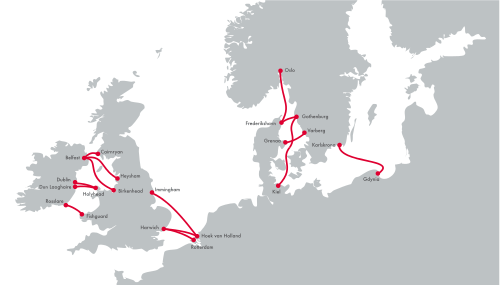
Irish Sea
- Fishguard – Rosslare: Stena Europe
- Holyhead – Dublin Port: Stena Adventurer, Stena Estrid
- Belfast – Cairnryan: Stena Superfast VII, Stena Superfast VIII
- Belfast – Heysham: Stena Hibernia, Stena Precision
- Belfast – Birkenhead: Stena Edda, Stena Mersey, Stena Forerunner
- Cherbourg – Rosslare: Stena Horizon
North Sea
- Hook of Holland – Harwich: Stena Britannica, Stena Hollandica
- Hook of Holland – North Killingholme Haven: Stena Transit, Stena Transporter
- Rotterdam – Harwich: mv. Somerset, mv. Misida
- Rotterdam – North Killingholme Haven: "mv Stena Forerunner" "mv. Misana"
Scandinavia, Poland and Germany
- Gothenburg – Fredrikshavn: Stena Jutlandica, Stena Danica, Stena Vinga
- Halmstad – Grenå: Stena Nautica
- Gothenburg – Kiel: Stena Germanica, Stena Scandinavica
- Oslo – Fredrikshavn: Stena Saga - Closed 19th March 2020
- Karlskrona – Gdynia: Stena Spirit, Stena Vision, Stena Baltica
- Nynäshamn – Ventspils: Scottish Viking, Stena Flavia
- Trelleborg – Rostock: Mecklenburg Vorpommern, Skåne
- Trelleborg – Sassnitz: Sassnitz
- Travemünde – Liepāja: Urd, Stena Gothica
Fleet
Current ships
| Name | Built | Gross Tonnage | Passengers | Notes | Images |
|---|---|---|---|---|---|
| Stena Estrid | 2019 | 40,500 | 927 | The first E-Flexer Class ship for Stena Line | |
| Stena Edda | 2019 | 41,671 | 927 | The second E-Flexer Class ship for Stena Line |  |
| Stena Adventurer | 2003 | 43,532 | 1,500 | 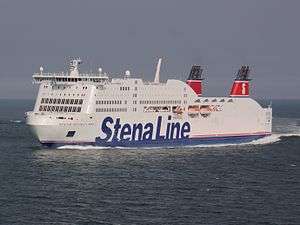 | |
| Stena Baltica | 2007 | 22,542 | 200 | 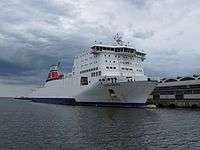 | |
| Stena Britannica | 2010 | 63,039 | 1,200 | 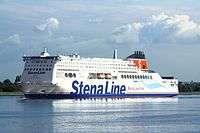 | |
| Stena Danica | 1983 | 15,899 | 2,300 |  | |
| Stena Europe | 1981 | 24,828 | 1,400 |  | |
| Stena Flavia | 2008 | 26,904 | 830 | ||
| Stena Germanica | 2001 | 51,837 [11] | 1,300 | 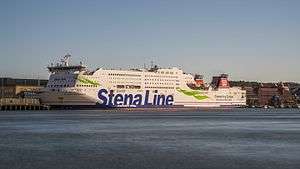 | |
| Stena Hibernia | 1996 | 13,017 | 12 | 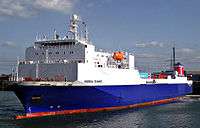 | |
| Stena Hollandica | 2010 | 63,039 | 1,200 | 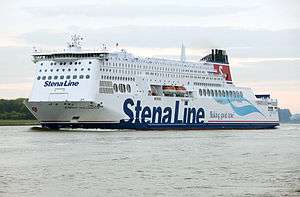 | |
| Stena Horizon | 2006 | 27,552 | 972 | 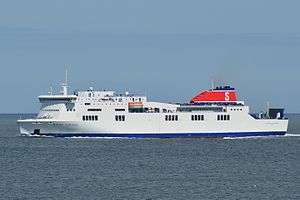 | |
| Stena Jutlandica | 1996 | 29,691 | 1,500 | 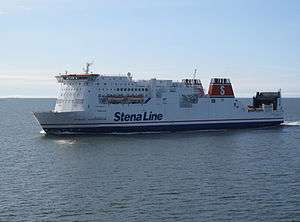 | |
| Stena Lagan | 2005 | 26,500 | 980 | 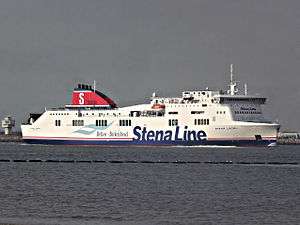 | |
| Stena Mersey | 2005 | 26,500 | 980 | .jpg) | |
| Stena Nautica | 1986 | 11,763 | 663 |  | |
| Stena Nordica | 2000 | 24,206 | 405 | 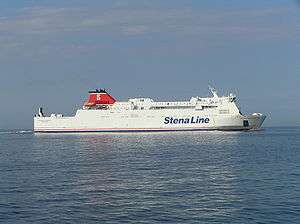 | |
| Stena Saga | 1981 | 25,905 | 2,000 |  | |
| Stena Scandinavica | 2003 | 55,050 | 900 |  | |
| Stena Scotia | 1996 | 13,600 | 12 |  | |
| Stena Spirit | 1988 | 39,193 | 1,700 |  | |
| Stena Superfast VII | 2001 | 30,285 | 1,200 | Dec'17: Stena took ownership from Tallink | |
| Stena Superfast VIII | 2001 | 30,285 | 1,200 | Dec'17: Stena took ownership from Tallink | 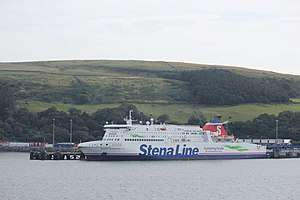 |
| Stena Transit | 2011 | 33,690 | 300 | .jpg) | |
| Stena Transporter | 2011 | 33,690 | 300 | .jpg) | |
| Stena Vision | 1981 | 39,178 | 1,700 | 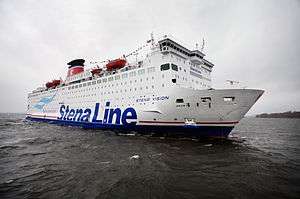 | |
| Sassnitz | 1989 | 20,276 | 900 |  | |
| Skane | 1998 | 28,960 | 600 | 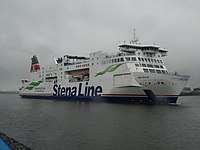 | |
| Somerset (formerly Spaarneborg) | 1999 | 12 | |||
| Stena Vinga | 2005 | 400 |  | ||
| Urd | 1981 | 110,30 | 186 | _in_Rostock_(01-2).jpg) | |
| Scottish Viking | 2008 | 26,904 | 830 | 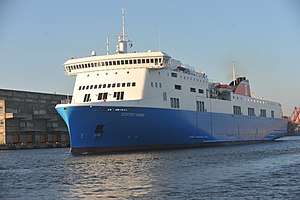 | |
| Stena Forerunner | 2003 | 12 | |||
| Mecklenburg-Vorpommen | 1996 | 37,987 | 600 | 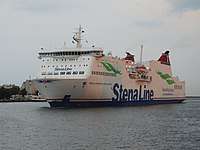 | |
| Stena Forecaster | 2003 | 12 | |||
| Stena Gothica (formerly Ask) | 1982 | 13,294 | 186 | 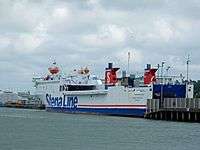 | |
Gallery
- Stena Traveller at the Hook of Holland
- Stena Traveller at the Hook of Holland
References
Notes
- Chiefly a freight route. However passengers and cars are transported
- "Sessan Linjen" (in Swedish). Fakta om Fartyg. Archived from the original on 1 August 2012. Retrieved 21 September 2007.
- "Lion Ferry" (in Swedish). Fakta om Fartyg. Archived from the original on 29 July 2012. Retrieved 21 September 2007.
- "Stoomvaart Maatschappij Zeeland" (in Swedish). Fakta om Fartyg. Archived from the original on 31 July 2012. Retrieved 21 September 2007.
- "Press release 9. 11. 2006". Aker Yards. Retrieved 21 September 2007.
- "Stena Line announces major investment in innovative ferries". Stena Line press release. Retrieved 21 September 2007.
- "'Superferry' in maiden Harwich crossing". BBC News. 16 May 2010. Retrieved 16 May 2010.
- "EU gives green light to Stena Hyundai Glovis joint-venture". World maritime News. 5 February 2019. Retrieved 12 August 2019.
- "DFDS sells Irish Sea ferry routes". DFDS A/S. Retrieved 3 December 2010.
- "Stena Line buys Celtic Link ferry service". RTÉ News. 26 February 2014. Retrieved 27 February 2014.
- "Stena Line – Our ships". Retrieved 12 August 2013.
- "Stena's new formula for ro-pax market". The Motorship. 14 June 2018. Retrieved 16 September 2018.
- "Stena Lifts Options for Two More E-Flexer Ships". World Maritime News. 18 July 2018. Retrieved 16 September 2018.
Bibliography
- Brogren, Klas; Bergenek, Anders; Sahlsten, Rickard (2012). Stena Line: the story of a ferry company. Göteborg: Stena Line. ISBN 9789186687236.
- Cowsill, Miles; Hendy, John; Haalmeijer, Frank (1993). Harwich-Hoek van Holland: 100 years of service / 100 jaar verdienst. Narberth, Pembrokeshire: Ferry Publications. ISBN 1871947154.
- Cowsill, Miles; Hendy, John (1996). Holyhead-Dun Laoghaire: from car ferry to HSS. Narberth, Pembrokeshire: Ferry Publications. OCLC 484331905.
- Cowsill, Miles; Hendy, John (1997). Stena Line: the fleet. Narberth, Pembrokeshire: Ferry Publications. ISBN 1871947448.
- Cowsill, Miles (2006). Fishguard-Rosslare: the official 1906-2006 anniversary book of Stena Line. Ramsey, Isle of Man: Ferry Publications. ISBN 1871947820.
- Cowsill, Miles (1998). Stranraer-Larne: the car-ferry era. Narberth, Pembrokeshire: Ferry Publications. ISBN 1871947405.
- Harvey, W.J. (1989). Stena Gothenburg 1939-1989. Göteborg: Stena AB. ISBN 9185786411.
- Harvey, W.J. (2006). Stena: a group fleet history. Windsor: World Ship Society. ISBN 0954331079.
- Haws, Duncan (1993). Britain's Railway Steamers: Western & Southern Companies + French & Stena. Merchant Fleets series, no. 24. Hereford: TCL Publications. ISBN 0946378215.
- Haws, Duncan (1993). Britain's Railway Steamers: Eastern & North Western Companies + Zeeland and Stena. Merchant Fleets series, no. 25. Hereford: TCL Publications. ISBN 0946378223.
- Haws, Duncan (1994). Britain's Railway Steamers: Scottish & Irish Companies + Stena and Macbrayne. Merchant Fleets series, no. 26. Hereford: TCL Publications. ISBN 0946378231.
- Hendy, John (1993). Ferries of Dover. Staplehurst, Kent: Ferry Publications. ISBN 0951350692.
- Hendy, John (1997). Ferry Port Dover: the development of cross-channel vehicle ferries, their services and allied infrastructure. Staplehurst, Kent: Ferry Publications. ISBN 1871947472.
- Merrigan, Justin P.; Collard, Ian H. (2010). Holyhead to Ireland: Stena and its Welsh heritage. Chalford, Gloucestershire: Amberley Publishing. ISBN 9781848689589.
- Peter, Bruce (2012). Stena Line: Celebrating 50 years of service. Ramsey, Isle of Man: Ferry Publications. ISBN 9781906608507.
- Sahlsten, Rickard; Söderberg, Bertil; Bång, Krister. Stena Line's Ships 1962-1992. Göteborg: Stena Line. OCLC 476605445.
- Widdows, Nick (2011). Stena Line: the fleet. Ramsey, Isle of Man: Ferry Publications. ISBN 9781906608415.
External links
| Wikimedia Commons has media related to Stena Line. |
- Stena Line – Corporate site
- Stena Line Reservations – UK online ticket reservations and home pages
- Stena Line Reservations – Swedish online ticket reservations and home pages
- Stena Line Reservations – Czech online ticket reservations and home pages